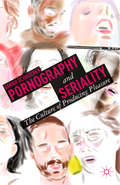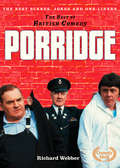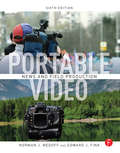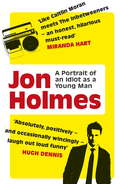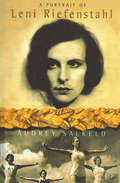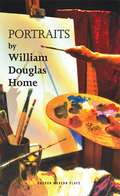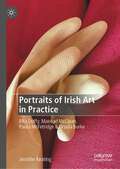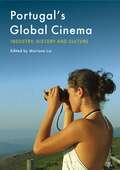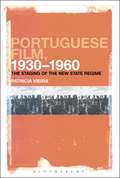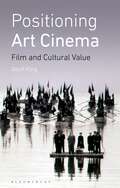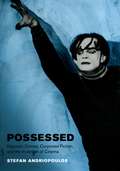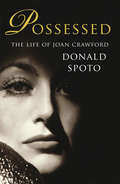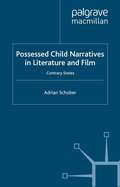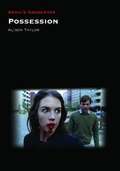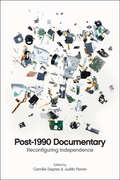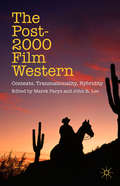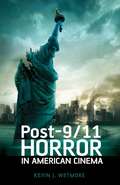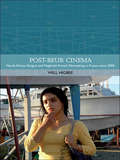- Table View
- List View
Pornography and Seriality: The Culture of Producing Pleasure
by S. SchaschekRepetition and seriality are inherent in pornography and is constitutive for its functionality as a film genre, an industry, and an area of gender studies. By linking the styles of the genre to processes of serial production, consumption, and discussion, Schaschek questions the dominant assumptions about pornography and the stability of the genre.
Porridge: The Inside Story (The Best of British Comedy)
by Richard WebberThe best jokes, gags and scenes from a true British comedy classic. ‘Cheer up, could be worse. State the country's in, we could be free.’
Portable Video: ENG & EFP
by Norman Medoff Edward J. FinkPortable Video: ENG and EFP, Fifth Edition" focuses on the techniques and technology of single camera electronic news gathering and electronic field production. Covering everything from basic creative and technical editing techniques to budgets and copyright issues, it is accessible to the home videomaker or amateur and to the professional seeking information on the newest advances in technique and equipment. It includes special focus on TV news production and field production and is suitable for complete beginners.
Portable Video: ENG & EFP
by Norman Medoff Edward J. FinkPortable Video: ENG and EFP, Fifth Edition" focuses on the techniques and technology of single camera electronic news gathering and electronic field production. Covering everything from basic creative and technical editing techniques to budgets and copyright issues, it is accessible to the home videomaker or amateur and to the professional seeking information on the newest advances in technique and equipment. It includes special focus on TV news production and field production and is suitable for complete beginners.
A Portrait of an Idiot as a Young Man: Part memoir, part explanation as to why men are so rubbish
by Jon HolmesWhen Jon Holmes became a father (twice), he was asked to fill in a form detailing his family medical history. Except he couldn't, because he has no idea who his family are. Born to an unnamed, unmarried mother and an unknown father and given up for adoption at four weeks old, Jon decided to document his own history, so that one day he could pass it on to his children. It's a story of how boys grow up to become (stupid) men, of sexual misadventure, of being accidentally shot in the face, of spiders, a ghost, a fatally injured gerbil, American road trips that went wrong, becoming inadvertently locked in Graham Norton's toilet with an Oscar nominated screenwriter, being removed from Mrs Thatcher's vicinity by her security detail and having loving parents who did their best to bring up a child that wasn't theirs. Part memoir, part hilarious insight into why men are so inept, this is the true story of how an unwanted baby in the Midlands went on to become a wanted man in the state of Texas, and everything that happened in between.His children will never be allowed to read it.
A Portrait Of Leni Riefenstahl
by Audrey SalkeldLeni Riefenstahl will always be remembered for her brilliant film of the 1936 Olympic Games in Berlin - still rated as one of the best documentaries ever made. Before that she was acclaimed for her roles in silent feature films, when German cinema was in its artistic heyday in the 1920s. She pioneered the box office success of such classic mountaineering dramas as The White Hell of Piz Palu and then began to direct her own films. The Blue Light was admired by Hitler and led to her filming the Wagnerian Nuremberg Rally of 1934. After the war she was shunned by the film industry, despite a court in 1952 proclaiming her not guilty of supporting the Nazis in a punishable way. Her undoubted charisma led to many affairs and grandiose schemes - deep sea diving in her seventies and still filming wildlife in her nineties. Audrey Salkeld has sifted the fact from the legend and gives us a moving portrait of the great movie `star' who suffered more in the `wilderness' than her enduring fame suggests.
Portraits (Oberon Modern Plays)
by William Douglas-HomeAugustus John's ability as portrait artist won him the admiration of fellow artists, public recognition and the Order of Merit. William Douglas Home's play presents various points in the Bohemian artist's turbulent life from 1944 – 1961 through a reconstruction of sittings with three of his subjects (all played by the same actor) – General Bernard Montgomery, fellow artist Mathew Smith and designer Cecil Beaton. This keenly observed, sensitive play is finely interwoven with the thread of John's gradually developing pacifism – from his certainty in spring 1944 that Monty's young ADC will not survive the second front, to war's devastating effect on Matthew Smith, to John's vibrant fear of the nuclear nightmare and his own approaching death. The first production of this play in 24 years, Portraits commemorates the 50th anniversary of the death of artist Augustus John.
Portraits of Irish Art in Practice: Rita Duffy, Mairéad McClean, Paula McFetridge & Ursula Burke
by Jennifer KeatingThis book mines the space where aesthetic expression meets lived experience for Irish artists Rita Duffy, Mairéad McClean, Paula McFetridge and Ursula Burke. Portrait essays woven with photographs, document each artist’s coming of age in Ireland and Northern Ireland, in the context of her emerging practice. As individuals, their work considers infringements on human rights, systemic violence, gender roles and the negotiation of figurative and literal borders and boundaries. Together, they interrogate past and present conflict and emergence from conflict, locally and globally. Their critical work is threaded with hope in the context of past and present political fragmentation. Works considered include Rita Duffy’s paintings, drawings and animation like Siege, The Emperor Has No Clothes and Anatomy of Hope; Mairéad McClean’s films No More, Broadcast and Making Her Mark; Paula McFetridge’s productions like convictions, staged at the Crumlin Road Courthouse, This is What We Sang, performed at the Belfast Synagogue and Belfast Quartered, A Love Story, a promenade through Belfast’s LGBTQ+ underground; and Ursula Burke’s sculptures like Bonfire, Blue Sphinx and Peach Caryatid, and embroidery like The Politicians Frieze.
Portugal's Global Cinema: Industry, History and Culture (World Cinema)
by Mariana LizPortuguese cinema has become increasingly prominent on the international film festival circuit, proving the country's size belies its cultural impact. From the prestige of directors Manoel de Oliveira, PePortugal's Global Cinemadro Costa and Miguel Gomes, to box-office hit La Cage Dorée, aspects of Portuguese national cinema are widely visible although the output is comparatively small compared to European players like the UK, Germany and France. Considering this strange discrepancy prompts the question: how can Portuguese cinema be characterised and thought about in a global context? Accumulating expertise from an international group of scholars, this book investigates the shifting significance of the nation, Europe and the globe for the way in which Portuguese film is managed on the international stage. Chapters argue that film industry professionals and artisans must navigate complex globalised systems that inform their filmmaking decisions. Expectations from multi-cultural audiences, as well as demands from business investors and the criteria for critical accolades put pressure on Portuguese cinema to negotiate, for example, how far to retain national identities on screen and how to interact with 'popular' and 'art' film tropes and labels. Exploring themes typical of Portuguese visual culture – including social exclusion and unemployment, issues of realism and authenticity, and addressing Portugal's postcolonial status – this book is a valuable study of interest to the ever-growing number of scholars looking outside the usual canons of European cinema, and those researching the ongoing implications of national cinema's global networks.
Portuguese Film, 1930-1960: The Staging of the New State Regime
by Patricia VieiraPortuguese Film, 1930-1960: The Staging of the New State Regime provides groundbreaking analysis of Portuguese feature films produced in the first three decades of the New State (Estado Novo), a right-wing totalitarian regime that lasted between 1933 and 1974. These films, sponsored by the National Propaganda Institute (Secretariado Nacional de Propaganda), convey a conservative image of both mainland Portugal and the country's overseas African colonies (Angola, Mozambique, Cape Verde, Guinea-Bissau and St. Thomas and Principe). The films about the mainland emphasize traditional values, the importance of obedience to authorities and a strict division of gender roles, whereby women are relegated to the domestic sphere. The Portuguese countryside, where age-old customs and a strong social hierarchy prevailed, is presented in these movies as a model for the rest of the country. The films about the colonies, in turn, underline the benefits of the Portuguese presence in Africa and portray the colonized as docile subjects to Portuguese rule. The book includes chapter summaries in the introduction, in-depth analyses of the most important Portuguese films produced between 1930 and 1960, a discussion of the main topics of Portuguese cinema from the New State, and a comprehensive bibliography that guides students who wish to read further on a specific topic. First published in Portuguese to wide acclaim, Portuguese Film, 1930-1960: The Staging of the New State Regime fills a gap in English-language scholarship on the history of the national cinema of the Iberian peninsula. Films covered include Fatima, Land of Faith (Terra de Fe), Spell of the Empire (Feitico do Imperio), and Chaimite.
Portuguese Film, 1930-1960: The Staging of the New State Regime
by Patricia VieiraPortuguese Film, 1930-1960: The Staging of the New State Regime provides groundbreaking analysis of Portuguese feature films produced in the first three decades of the New State (Estado Novo), a right-wing totalitarian regime that lasted between 1933 and 1974. These films, sponsored by the National Propaganda Institute (Secretariado Nacional de Propaganda), convey a conservative image of both mainland Portugal and the country's overseas African colonies (Angola, Mozambique, Cape Verde, Guinea-Bissau and St. Thomas and Principe). The films about the mainland emphasize traditional values, the importance of obedience to authorities and a strict division of gender roles, whereby women are relegated to the domestic sphere. The Portuguese countryside, where age-old customs and a strong social hierarchy prevailed, is presented in these movies as a model for the rest of the country. The films about the colonies, in turn, underline the benefits of the Portuguese presence in Africa and portray the colonized as docile subjects to Portuguese rule. The book includes chapter summaries in the introduction, in-depth analyses of the most important Portuguese films produced between 1930 and 1960, a discussion of the main topics of Portuguese cinema from the New State, and a comprehensive bibliography that guides students who wish to read further on a specific topic. First published in Portuguese to wide acclaim, Portuguese Film, 1930-1960: The Staging of the New State Regime fills a gap in English-language scholarship on the history of the national cinema of the Iberian peninsula. Films covered include Fatima, Land of Faith (Terra de Fe), Spell of the Empire (Feitico do Imperio), and Chaimite.
Positioning Art Cinema: Film and Cultural Value (International Library of the Moving Image (PDF))
by Geoff KingArt cinema occupies a space in the film landscape that is accorded a particular kind of value. From films that claim the status of harsh realism to others which embody aspects of the tradition of modernism or the poetic, art cinema encompasses a variety of work from across the globe.But how is art cinema positioned in the film marketplace, or by critics and in academic analysis? Exactly what kinds of cultural value are attributed to films of this type and how can this be explained? This book offers a unique analysis of how such processes work, including the broader cultural basis of the appeal of art cinema to particular audiences.Geoff King argues that there is no single definition of art cinema, but a number of distinct and recurrent tendencies are identified. At one end of the spectrum are films accorded the most 'heavyweight' status, offering the greatest challenges to viewers. Others mix aspects of art cinema with more accessible dimensions such as uses of popular genre frameworks and 'exploitation' elements involving explicit sex and violence. Including case studies of key figures such as Michael Haneke, Pedro Almodóvar and Jean-Pierre and Luc Dardenne, this is a crucial contribution to understanding both art cinema itself and the discourses through which its value is established.
Positioning Art Cinema: Film and Cultural Value (International Library of the Moving Image (PDF))
by Geoff KingArt cinema occupies a space in the film landscape that is accorded a particular kind of value. From films that claim the status of harsh realism to others which embody aspects of the tradition of modernism or the poetic, art cinema encompasses a variety of work from across the globe.But how is art cinema positioned in the film marketplace, or by critics and in academic analysis? Exactly what kinds of cultural value are attributed to films of this type and how can this be explained? This book offers a unique analysis of how such processes work, including the broader cultural basis of the appeal of art cinema to particular audiences.Geoff King argues that there is no single definition of art cinema, but a number of distinct and recurrent tendencies are identified. At one end of the spectrum are films accorded the most 'heavyweight' status, offering the greatest challenges to viewers. Others mix aspects of art cinema with more accessible dimensions such as uses of popular genre frameworks and 'exploitation' elements involving explicit sex and violence. Including case studies of key figures such as Michael Haneke, Pedro Almodóvar and Jean-Pierre and Luc Dardenne, this is a crucial contribution to understanding both art cinema itself and the discourses through which its value is established.
Possessed: Hypnotic Crimes, Corporate Fiction, and the Invention of Cinema (Cinema and Modernity)
by Stefan AndriopoulosSilent cinema and contemporaneous literature explored themes of mesmerism, possession, and the ominous agency of corporate bodies that subsumed individual identities. At the same time, critics accused film itself of exerting a hypnotic influence over spellbound audiences. Stefan Andriopoulos shows that all this anxiety over being governed by an outside force was no marginal oddity, but rather a pervasive concern in the late nineteenth and early twentieth centuries. Tracing this preoccupation through the period’s films—as well as its legal, medical, and literary texts—Andriopoulos pays particular attention to the terrifying notion of murder committed against one’s will. He returns us to a time when medical researchers described the hypnotized subject as a medium who could be compelled to carry out violent crimes, and when films like The Cabinet of Dr. Caligari and Dr. Mabuse, the Gambler famously portrayed the hypnotist’s seemingly unlimited power on the movie screen. Juxtaposing these medicolegal and cinematic scenarios with modernist fiction, Andriopoulos also develops an innovative reading of Kafka’s novels, which center on the merging of human and corporate bodies. Blending theoretical sophistication with scrupulous archival research and insightful film analysis, Possessed adds a new dimension to our understanding of today’s anxieties about the onslaught of visual media and the expanding reach of vast corporations that seem to absorb our own identities.
Possessed: Hypnotic Crimes, Corporate Fiction, and the Invention of Cinema (Cinema and Modernity)
by Stefan AndriopoulosSilent cinema and contemporaneous literature explored themes of mesmerism, possession, and the ominous agency of corporate bodies that subsumed individual identities. At the same time, critics accused film itself of exerting a hypnotic influence over spellbound audiences. Stefan Andriopoulos shows that all this anxiety over being governed by an outside force was no marginal oddity, but rather a pervasive concern in the late nineteenth and early twentieth centuries. Tracing this preoccupation through the period’s films—as well as its legal, medical, and literary texts—Andriopoulos pays particular attention to the terrifying notion of murder committed against one’s will. He returns us to a time when medical researchers described the hypnotized subject as a medium who could be compelled to carry out violent crimes, and when films like The Cabinet of Dr. Caligari and Dr. Mabuse, the Gambler famously portrayed the hypnotist’s seemingly unlimited power on the movie screen. Juxtaposing these medicolegal and cinematic scenarios with modernist fiction, Andriopoulos also develops an innovative reading of Kafka’s novels, which center on the merging of human and corporate bodies. Blending theoretical sophistication with scrupulous archival research and insightful film analysis, Possessed adds a new dimension to our understanding of today’s anxieties about the onslaught of visual media and the expanding reach of vast corporations that seem to absorb our own identities.
Possessed: The Life of Joan Crawford
by Donald Spoto'I've been protected by studio publicity men most of my life, so in some ways I'm a goddam image, not a person. I was a commodity, a piece of property... I felt an overwhelming obligation to my career, and so I was an actress first, a wife second. I worked almost constantly, and even when I wasn't working, there was that image thing of looking like a star, conducting myself like a star. I just went ahead like a bulldozer. I was a very selfish woman.'Joan Crawford was a complex, contradictory, driven human being, but not the alcoholic, sadistic monster depicted in the notorious book, Mommie Dearest, which appeared a year after her death. In some ways, Donald Spoto's Possessed is the ultimate Hollywood book - about a young woman, poor, abandoned by her father, but determined at all costs to succeed . Born in Texas, Lucille Fay LeSueur escaped destitution by becoming a popular dancer and then managed to make the decisive leap that transformed her into a luminous, unique star of the screen. She became Joan Crawford.There were many important men in her life, not least Clark Gable, with whom she appeared in eight pictures and with whom she conducted a thirty-year affair. She was married four times, once to the debonair Douglas Fairbanks Jr, unaware that he had failed to discontinue his relationship with Marlene Dietrich. Dancer, dramatic actress, businesswoman, corporate executive with Pepsi-Cola, Joan Crawford during her lifetime (1906 - 1977) was rarely out of the news. With the use of only recently opened archives and personal papers, Donald Spoto probes behind the lurid headlines to bring us Joan Crawford, the private person as well as the movie legend.
Possessed Child Narratives in Literature and Film: Contrary States (Crime Files)
by A. SchoberThis book undertakes a study of the trope of possessed child in literature and film. It argues that the possessed child is fundamentally an American phenomenon which, first, may be traced to the Calvinist bias of the US as a nation founded on Puritanism and, second, to the rise of Catholicism in that country, to which Puritanism owes its origins.
Possession (Devil's Advocates)
by Alison TaylorPremiering at the 1981 Cannes Film Festival, Andrzej Żuławski’s Possession remains a distinct phenomenon. Though in competition for the illustrious Palme d’Or, its art cinema context did not rescue it from being banned as part of the United Kingdom’s ‘video nasties’ campaign, alongside unashamedly lowbrow titles such as Faces of Death and Zombie Flesh Eaters. Skirting the boundary between art and exploitation, body horror and cerebral reverie, relationship drama and political statement, Possession is a truly astonishing film. Part visceral horror, part surreal experiment, part gothic romance dressed in the iconography of a spy thriller: there is no doubt that the polarity evinced by Possession’s initial release was in part a product of its resistance to clear categorisation.With a production history almost as bizarre as the film itself, a cult following gained with its VHS release, and being re-appreciated in the decades since as a valuable work of auteur cinema, the story of how this film came to be is as fascinating as it is unfathomable. Alison Taylor’s Devil’s Advocate considers Possession’s history, stylistic achievement, and legacy as an enduring and unique work of horror cinema. Beginning with a marital breakdown and ending with an apocalypse, the film’s strangeness has not dissipated over time; its transgressive imagery, histrionic performances, and spiral staircase logic remain affective and confounding to critics and fans alike. Respecting the film’s wilfully enigmatic nature, this book helps to unpack its key threads, including the collision between the banal and the horrific, the socio-historical context of its divided Berlin setting, and the significance of its legacy, particularly with regard to the contemporary trend for extreme art horror on the festival circuit.
Post-1990 Documentary: Reconfiguring Independence
by Camille Deprez Judith PerninThis book questions the meanings of ‘independence’ for documentaries made in the post-1990 context, a period of unrivalled disruption and creativity in the field. Based upon a reasoned selection of contributions, it is the first collection of in-depth case studies cutting across formats, media, subject matters, purposes and national divides. Writing from a wide range of academic perspectives, the contributors shed new light on historical, theoretical and empirical issues pertaining to the independent documentary, in order to better comprehend the radical transformations of the form over the past twenty-five years. Compared to existing studies, this volume focuses on works and practitioners existing at the margins of the traditional media, the mainstream film industry and the prevailing economic and socio-political systems; yet greatly contributing to changing our perception of documentaries. And in doing so, it addresses an important gap in the global understanding of documentary practices and styles.
Post-1990 Documentary: Reconfiguring Independence
by Camille Deprez Judith PerninThis book questions the meanings of ‘independence’ for documentaries made in the post-1990 context, a period of unrivalled disruption and creativity in the field. Based upon a reasoned selection of contributions, it is the first collection of in-depth case studies cutting across formats, media, subject matters, purposes and national divides. Writing from a wide range of academic perspectives, the contributors shed new light on historical, theoretical and empirical issues pertaining to the independent documentary, in order to better comprehend the radical transformations of the form over the past twenty-five years. Compared to existing studies, this volume focuses on works and practitioners existing at the margins of the traditional media, the mainstream film industry and the prevailing economic and socio-political systems; yet greatly contributing to changing our perception of documentaries. And in doing so, it addresses an important gap in the global understanding of documentary practices and styles.
The Post-2000 Film Western: Contexts, Transnationality, Hybridity
by Marek Paryz John R. LeoThis collection explores the post-2000 film Western. With examples ranging from major American films, through acclaimed international productions, to works such as experimental films and television commercials, the contributors seek to account for the appeal and currency of the film Western today.
Post-9/11 Cinema: Through A Lens Darkly (PDF)
by John MarkertCovering cinematic portrayals of 9/11 and the subsequent incursions into Iraq and Afghanistan, Post-9/11 Cinema: Through a Lens Darkly examines both dramas and documentaries that depict what some have termed "Bush's war," as well as rebuttal films, films about terrorist activities, and films seen from the vantage point of journalists and military personnel. This book not only shows how motion pictures reflect societal values but also how such works can influence social attitudes and thus promote change. In addition, Markert appraises the film industry and critiques how images are manipulated to sway the viewer to appreciate the side being advocated.
Post-9/11 Horror in American Cinema
by Kevin J. Wetmore Jr.The horror film is meant to end in hope: Regan McNeil can be exorcized. A hydrophobic Roy Scheider can blow up a shark. Buffy can and will slay vampires. Heroic human qualities like love, bravery, resourcefulness, and intelligence will eventually defeat the monster. But, after the 9/11, American horror became much more bleak, with many films ending with the deaths of the entire main cast. Post-9/11 Horror in American Cinema illustrates how contemporary horror films explore visceral and emotional reactions to the attacks and how they underpin audiences' ongoing fears about their safety. It examines how scary movies have changed as a result of 9/11 and, conversely, how horror films construct and give meaning to the event in a way that other genres do not. Considering films such as Quarantine, Cloverfield, Hostel and the Saw series, Wetmore examines the transformations in horror cinema since 9/11 and considers not merely how the tropes have changed, but how our understanding of horror itself has changed.
Post-9/11 Horror in American Cinema
by Kevin J. Wetmore Jr.The horror film is meant to end in hope: Regan McNeil can be exorcized. A hydrophobic Roy Scheider can blow up a shark. Buffy can and will slay vampires. Heroic human qualities like love, bravery, resourcefulness, and intelligence will eventually defeat the monster. But, after the 9/11, American horror became much more bleak, with many films ending with the deaths of the entire main cast. Post-9/11 Horror in American Cinema illustrates how contemporary horror films explore visceral and emotional reactions to the attacks and how they underpin audiences' ongoing fears about their safety. It examines how scary movies have changed as a result of 9/11 and, conversely, how horror films construct and give meaning to the event in a way that other genres do not. Considering films such as Quarantine, Cloverfield, Hostel and the Saw series, Wetmore examines the transformations in horror cinema since 9/11 and considers not merely how the tropes have changed, but how our understanding of horror itself has changed.
Post-beur Cinema: North African Émigré and Maghrebi-French Filmmaking in France since 2000 (Traditions in World Cinema)
by Will Higbee"Since the early 1980s and the arrival of Beur cinema filmmakers of Maghrebi origin have made a key contribution French cinema's representation of issues such as immigration, integration and national identity. However, they have done so mostly from a position on the margins of the industry. In contrast, since the early 2000s, Maghrebi-French and North African émigré filmmakers have occupied an increasingly prominent position on both sides of the camera, announcing their presence on French screens in a wider range of genres and styles than ever before. This greater visibility and move to the mainstream has not, however, automatically meant that these films have lost any of the social or political relevance. Indeed in the 2000s many of these films have increasingly questioned the boundaries between national, transnational and diasporic cinema, whilst simultaneously demanding, either implicitly or explicitly, a reconsideration of the very difference that has traditionally been seen as a barrier to the successful integration of North African immigrants and their descendants into French society. Through a detailed study of this transformative decade for Maghrebi-French and North African émigré filmmaking in France, this book argues for the emergence of a 'Post-Beur' cinema in the 2000s that is simultaneously global and local in its outlook. "
